Metamorphoses of the Virtues of Love in Medicean Florence
A Reading of Plate 39 of the Mnemosyne Atlas
by Seminario Mnemosyne | Centre for Classical Studies Iuav, coordinated by Giulia Bordignon, Monica Centanni, Alessandra Pedersoli, with Enkelejd Doja, Bianca Maria Fasiolo, Anna Fressola, Filippo Lorenzin, Linda Vigiani, Annalisa Zegna
English version by Elizabeth Thomson
English abstract | Versione italiana
The Seminary of Classical Studies at the University Iuav of Venice presents an analysis of Plate 39 in the Mnemosyne Atlas, together with a high-definition image of the plate, captions and image details (see Mnemosyne Atlas and the web page for Plate 39).
As heralded by the Triumphs of the goddess of Love, and by the central figure of Venus, Plate 39 is permeated by the daemon of Eros. The blindfold Cupid [39.11a], in glory with his mother [39.2a e 39.2b], or as a symbol of the love pact between the two young people [39.3], fires the bonds and exchanges of erotic passion and demonstrations of love, as he does the violent and passionate abductions which occur in the upper section of the plate [39.2a e 39.2b, 39.9, 39.11b, 39.11c, 39.3].

Mnemosyne Atlas, plate 39 (details from Warburg and coll. version, 1929) captions 39.2a, 39.2b, 39.9, 39.11a, 39.11b, 39.11c, 39.3, 39.2a “I figli del Pianeta Venere”, etching on copper, from Calendario Baldini, first edition, about 1460; 39.2b “I figli del Pianeta Venere”, etching on copper, from Calendario Baldini, second edition, 1465; 39.9 Sandro Botticelli, The Birth of Venus, tempera on panel, 1482-85, Florence, Galleria degli Uffizi; 39.11a Sandro Botticelli, Primavera (according to Aby Warburg, the representation of the Kingdom of Venus), tempera on panel, 1477-82, Florence, Galleria degli Uffizi; 39.11b Sandro Botticelli, Chloris, detail from figure 39.11a; 39.11c Sandro Botticelli, Zephyr, detail from figure 39.11a; 39.3 Lorenzo de’ Medici and Lucrezia Donati, “Amor vuol fe”, etching on copper, 1465-80, Paris, Bibliothèque Nationale.
The ultimate effect of the transfiguring encounter with Eros – Amor in “antiquicising” dress, the exact definition given by Warburg in his notes on the plate – is the return to Earth of the desired or abducted female metamorphosed into the form of a plant: Chloris-Flora, the fertile bride of Zephyr [39.11a, 39.11b], and Daphne-Laurel, poetic glory and chaste fruit of Apollo’s amorous rapture [39.15, 39.16, 39.18, 39.19].

Mnemosyne Atlas, plate 39 (details from Warburg and coll. version, 1929) captions 39.15, 39.16, 39.18, 39.19:
39.15 Antonio Pollaiuolo, Apollo and Daphne, tempera on panel, 1472-73, London, National Gallery;
39.16 Attributed to Giovanni Pietro Birago, Apollo and Daphne, manuscript miniature, last third of the fifteenth century, Wolfenbüttel, Herzog August Bibliothek; 39.18 Sandro Botticelli, Pallas and the Centaur, tempera on canvas, 1482, Florence, Galleria degli Uffizi; 39.19 Bernardino Luini, Apollo and Daphne (The Tale of Myrrha?), fresco fragment, from Villa Pelucca in Monza, 1520-23, Milan, Pinacoteca di Brera.
The first image top left on the montage (see the panel) is a relief portraying Icarus, winged and now ready for his overconfident flight towards Apollo-Helios [39.1].
The relief is one of twelve stone medallions on the frieze of Michelozzo’s courtyard in Palazzo Medici Riccardi, made in 1465 circa, attributed to the workshop of Donatello and perhaps the craftsmanship of Bertoldo di Giovanni (Dacos, Giuliano, Pannuti 1973). A medallist, sculptor and expert archaeologist, Bertoldo was often at Lorenzo’s side, and had the task of maintaining the Garden of San Marco in which the archaeological collection of the Medici family was kept. As in other Mnemosyne panels, the image is useful firstly for an historical and geographical contextualization of the plate, and also to award it an emblematic 'seal' of style. Although the tondo does not represent, in effect, a love-erotic subject – the theme underlying the entire montage – the scene is set up as a privileged access point to present the milieu of the patron protagonist of Plate 39, and to summarize one of the thematic-formal links, namely – according to Warburg's notes – the maturation in precisely that cultural context of an antiquicising "ideal style".
Almost all twelve tondi in the courtyard of Palazzo Medici Riccardi, in fact, are inspired by antique gems found in the collections of the Italian courts that the Medici had seen (in person or through reproductions), but that they still did not possess (two gems, for example, were certainly in the collection of Pietro Barbo, who became Pope Paul II in 1464, and were bought by Lorenzo after his death). The set of tondi can therefore be considered a decorative device based on learned archaeological citations, rather than reverence for pieces in the collection (Dacos, Giuliano, Pannuti 1973): in order to corroborate this theory, we can show that one of the tondi in the courtyard – depicting a barbarian prisoner before a Roman general – refers not to a model derived from precious ancient engravings, but to the shorter side of a sarcophagus which during the fifteenth century was located along one side of the Baptistery in Florence. The only gem certainly documented in Lorenzo’s collection, however, is the one portraying Icarus, and it will not be superfluous to mention here that one of the images featured in Plate 39, the Birth of Venus by Botticelli, refers to another piece of Hellenistic glyptic art belonging to the Medici legacy, the famous Farnese Cup.
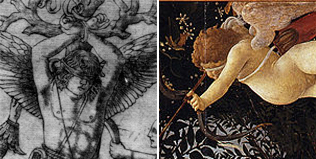
Baccio Baldini (attributed), The Chastisement of Cupid, engraving on copper, 1465-80 circa, location unknown, detail [38.14]; Sandro Botticelli, Primavera, tempera on panel, 1477-82, Florence, Galleria degli Uffizi, detail [39.11a].
Furthermore, the opening image in the plate reconnects this image to one of the themes addressed in the previous panel: Icarus, winged and standing on a pedestal, can be associated, from a postural perspective, with the Cupidus cruciatus present in the previous plate [38.14] (see Warburg [1905a] 1966, 177-178). In Plate 39 the sense of the punishment of Eros is overturned – in accordance with the dynamics of the energetic inversion of pathos repeatedly addressed by Warburg in Mnemosyne Atlas (see, in Engramma, Giulia Bordignon, L'espressione antitetica in Aby Warburg: Bordignon 2004 ) – and the erotic frigidity that Bertoldo himself had illustrated in Boccaccio’s exemplary novella Nastagio degli Onesti [38.4] would soon become, in the Florence of the Medici, the triumph of the virtue of Love. In the tondo on Plate 39, however, the raptus ad caelum of Icarus is not a rapture of love in the true sense. The wings here are totally instrumental to flight aiming at the achievement of excellence perhaps even of a metaphysical nature: an objective, however – given the context – that we can still consider ‘erotic’ in a neo-Platonic sense.
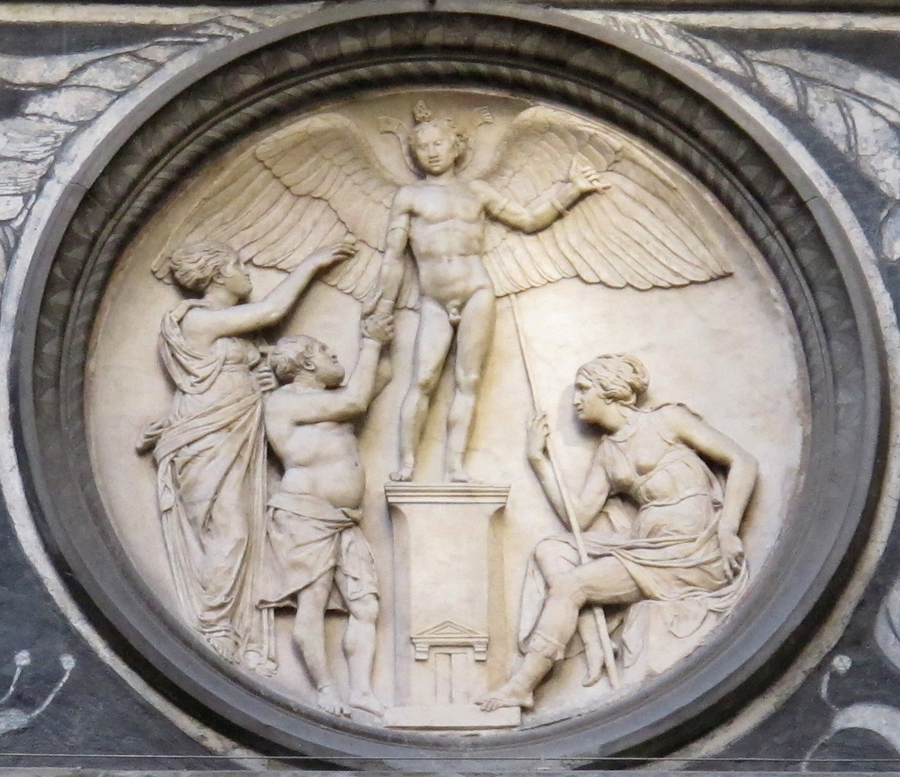
Workshop of Donatello, Bertoldo di Giovanni, Icarus and Daedalus, marble tondo, 1465, Florence, Palazzo Medici-Riccardi, courtyard [39.1].
As regards the iconographic analysis of the relief, a young man, with a wing already attached to his left arm, stands on a pedestal that unlike the gem shows a half-open door, perhaps an indication of a transition to an otherworldly dimension: the subject represented, therefore, would lend itself to an allegorical reading, such as the ascension of the soul. There is another iconographic variant that is significant in this respect, and distances the tondo from the ancient model: the young man's head is framed, behind the neck, by a sort of broad band, and on top of his head there is a lock of hair resembling a burning flame. On the left of Icarus, a bearded, elderly figure with a cloth around his waist, clearly his father Daedalus, holds the boy’s right arm, tightening the wing to his wrist using bands like those already fastened to his left arm, in a gesture that seems also to announce separation and parting. To the right sits a female figure: in her right hand, she holds a long staff, while the left arm is bent with her hand on her side holding back her draping garments. The figure is dressed in a chiton fastened under her bust with a himation tied around her neck, while the border of the boots shown in the gem are interpreted as the hem of short, tight pants; instead of the Phrygian cap, the Medici figure is coiffed with long locks of hair gathered around her head. The garments and attributes of a huntress, although different from the gem, refer to the iconography of Artemis. To the left of Daedalus there is a female figure, identified with Pasiphae (as the captions state on the official web site of Palazzo Medici-Riccardi), located in a higher and more prominent position compared to Daedalus. Dressed in a peplos which leaves her arms uncovered, the female figure holds out her right hand to Icarus. As is apparent from a comparison with the gem, in her left hand she holds a hammer in a pose similar to that of the artisans’ assistants as we see them represented in Greek and Hellenistic contexts: according to ancient sources, Pasiphae seems to have contributed to the escape of Daedalus and his son Icarus from the labyrinth in gratitude for the architect’s help in making the wooden erotic device, shaped like a cow, in which she hid in order to copulate with Poseidon’s bull (it was from this union that the monstrous Minotaur was born: for Pasiphae helping Daedalus see Diod., Bibl. Hist. IV, 77, 5; Serv., Comm. ad Aen. VI, 14).
Besides being an historical and thematic indicator, the Medici-Riccardi relief also shows several formal relationships with the other figures in the plate, especially the seated posture of Artemis in the tondo and that of Venus in both versions of the Baldini Calendar [39.2a and 39.2b], with her left arm slightly bent and her right leg crossed behind the left. In addition, the three figures wield a weapon in their left hand – Venus the arrow of Eros, and Artemis a spear. We can also detect a similarity in the gesture of the female figure in the tondo with the gesture of the Hour in The Birth of Venus [39.9]: both raise their arms towards the central figure, signalling the important central role it has. In the opening image, as well as in the group of Venus Hour in The Birth of Venus by Botticelli, the composition features ascending lines converging on the centre. In the first case, but also in the case of the Hour, the posture of the two figures alludes to flight (Icarus) and air (Hour).
The pioneering character of Warburg’s new approach to the formal analysis of factors derived from ancient models during the Renaissance - deductions that feature, as in the case just considered, significant and meaningful variations worthy of further analysis - was successfully highlighted by Gertrud Bing, after Warburg’s death, taking as a starting point the very images in Plate 39:
The round decorative reliefs in the courtyard of Palazzo Medici are imitations of antique gems whose originals were in the possession of Lorenzo. However, a discovery such as this went no further; no one had raised the issue of the intentions that determined the selection within the plastic treasures from antiquity. It was assumed that the artists of the fifteenth century were animated by the same admiration for classical antiquity that had been the rule obvious to any educated person from the eighteenth century onwards. Warburg too had initially started out using similar individual copies. His discovery that Botticelli had drawn on neo-Attic plastic models for his figures in motion or hovering in the air, almost flying, was of this kind. In a design that dates back to the school of Botticelli, a group of three figures had been copied from an ancient sarcophagus, which at that time was built into the steps of the Aracoeli in Rome. The novel twist that Warburg has given the history of tradition is not in asking what had been copied, or from what model was the copy derived: it consists, instead, of examining the why of a certain copy. He was thus able to see that when the artists or their customers and learned advisers chose their models, they were not primarily concerned with the content of ancient works, but in their language of gestures. The model for the rapid motion and the nervous gestures of Botticelli’s figures is the posture of the maenad from classical antiquity. The group of Apollo and Daphne in which the god tries to grasp his beloved became the prototype of the pursuit of love” (Bing [1960] 2014, 100-113).
Warburg’s critical intuition perceives that the re-use of antiquity during the Renaissance does not end simply with the recognition of an authoritative rule over aesthetics and content; it revives antiquity primarily for its expressive value.
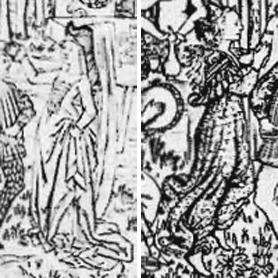
Dancing Nymph from “Venus and her children”, etching on copper, from the Baccio Baldini Calendar, first edition, 1460 circa [39.2a, 39.2b].
Next to the Medici-Riccardi tondo, the group includes, immediately to the right, an engraving (again, of Florentine origins) depicting the planetary children of Venus – or, according to the astrological science of humanistic age, those born during April-May who are influenced by the planet – from the first edition dated 1460 of the so-called 'Baldini Calendar'. The engraving is drawn from the second edition of the calendar, five years later, and is located in the panel below the opening image, placed at a certain distance from the first two images (on the relationship between the two versions of the ‘Baldini Calendar' and their significance in the montage of the Plate, see Rappl 2003). This spatial arrangement seems entirely intentional: the “all’antica” tondo and the first engraving appear to be juxtaposed, and the second, isolated on a black background, stands out as an additional pivot in the montage. Warburg himself proposes a line of interpretation that clarifies the compositional journey:
"In earlier impressions of the engraving, we find a lady dancing in the outworn splendor of the true Burgundian fashion: a clumsy train renders her earthbound, and her head is burdened with a hennin with a voluminous veil [cfr. 39.2a]. In later printings of the same planetary image, the antique butterfly has emerged from the Burgundian chrysalis: the dress flows free, like that of Victory herself; and a Medusa–winged headdress – a welcome aid to flight, for a nymph who dances on air – has banished the empty ostentation of the hennin [cfr. 39.2b]. This is the native idealism of grace in motion that Botticelli made into the noblest expressive resource of early Renaissance art.” (Warburg [1905b], The Renewal of Pagan Antiquity, introduction by K. W. Forster, trans. by D. Britt, Getty Research Institure for the History of Art and the Humanities, Los Angeles 1999, 176).
The Medici-Riccardi tondo, therefore, serves not only as a 'badge' summarizing the historical and geographical co-ordinates of Plate 39; it also summarises, from the opening image on the plate, the result of a stylistic and formal process that, in the short span of years in which the early Renaissance flowered under the aegis of Lorenzo, brought about a great revolution in the revival of the emotional expressiveness of antiquity in accordance with an ‘ideal style’, which in Warburg's view, was brought to fulfilment in the art of Botticelli. Warburg adds:
"As a result, it becomes possible to assess this unresolved blend of Northern popular comedy, quasi-French costume realism, and dynamic, quasi-antique idealism in gesture and drapery movement as a symptom of a crucial transitional phase in the emergence of secular Florentine art.” (Warburg [1905a], The Renewal of Pagan Antiquity, introduction by K. W. Forster, trans. by D. Britt, Getty Research Institure for the History of Art and the Humanities, Los Angeles 1999, 275).
In this age of transition, Botticelli’s style matures, and gives form to "accessories on the move" as hair and garments fluttering in the wind, which become a true pictorial cipher of the artist:
“The surface mobility of inanimate accessory forms, draperies and hair, which Poliziano commended to him as characteristic of antique works of art, was an easily manipulated external sign that could be added wherever he needed to create the semblance of intensified life. Botticelli readily made use of this expedient to show human figures in a state of excitement, or even of inner emotion.” (Warburg [1893], The Renewal of Pagan Antiquity, introduction by K. W. Forster, trans. by D. Britt, Getty Research Institure for the History of Art and the Humanities, Los Angeles 1999, 141) .
As far as the paintings are concerned, Warburg was the first to connect the Birth of Venus, the Kingdom of Venus (Primavera), and Pallas and the Centaur as part of a cycle, and to relate the works of Botticelli with the events of the 1470s which left their enduring mark on the history and perception of Florence during the era of the Medici. The traumatic and premature deaths of the famous lovers — Giuliano and the nymph Simonetta Cattaneo, who was married to a member of the Vespucci family — together with the celebration of the peace established once more by Lorenzo after the Pazzi conspiracy — as proved by Warburg and argued further by Wind — are the themes which inspire the three works of Botticelli commissioned by Lorenzo the Magnificent for Villa di Castello (see in Engramma the essay by Monica Centanni, 26 aprile giorno di primavera: nozze fatali nel giardino di Venere: Centanni 2013). Medici patronage, clearly evidenced by Giuliano’s emblem on the garment worn by Pallas [39.18], is confirmed in the Kingdom of Venus [39.11a], with particular reference to the fatal theme of the love-story between Giuliano and Simonetta, by Giuliano’s emblem; the rekindled branch embroidered in the chlamis of Mercury-Giuliano/Lorenzo di Pierfrancesco.

Mnemosyne Atlas, plate 39 (details from Warburg and coll. version, 1929) captions 39.9, 39.11a, 39.18:
39.9 Sandro Botticelli, The Birth of Venus, tempera on panel, 1482-85, Florence, Galleria degli Uffizi; 39.11a Sandro Botticelli, Primavera (according to Aby Warburg, the representation of the Kingdom of Venus), tempera on panel, 1477-82, Florence, Galleria degli Uffizi; 39.18. Sandro Botticelli, Pallas and the Centaur, tempera on canvas, 1482, Florence, Galleria degli Uffizi.
The very real difference in quality of the garments worn by the various characters may suggest further hermeneutic allusions useful for analysing the various compositional and thematic elements of the painting. The delicate wind-blown veils that reveal the bodies of the Graces, Chloris and Cupid, as well as the coloured garments that drape the limbs of Zephyrus, place these figures on the realms of mythology (see the passage from Leonardo da Vinci’s Trattato sulla pittura cited by Warburg and the commentary of plate 46 in Engramma): these figures can be readily associated with a classical mythographic source. However, one step ahead of the mythological scene, the ‘phantasms of antiquity’ are given bodily form in the two real figures in the foreground, the historical heroes of the composition. The characters of Giuliano and Simonetta (and perhaps, Semiramis and Lorenzo di Pierfrancesco Medici: see Centanni 2013), appear in the guise of Mercury and Flora, with their all’antica garments made with the sumptuous fabrics produced in contemporary Florence. In the third level of the scene, framed by a laurel halo, the standing figure that dominates the garden scene is wearing a nuptial gown – which can also be seen in other works of Botticelli – and she is draped in a double-faced cloak, red on one side and blue with stars on the other. This third typological garment alludes to yet another figural dimension. Behind the historical reality, and beyond the mythological framework, the general sense of the composition is determined and sustained by the principal allegorical and philosophical figure. Portrayed as a sacred bride, Venus, with Cupid fluttering above her, is Queen of the garden. However, she is also the double face of the Aphrodite of Ficino’s theories of love – sacred and profane, red and adorned with stars. Bountiful Venus in her kingdom-pomoerium has caused orange trees, still young in the Birth, to grow and blossom, and is now directing the scene with the gesture of her hand inviting Mercury-Giuliano – previously a protagonist in Poliziano’s Giostra in the guise of the hunter Julo – to convert from his wild and chaste persona, and enter the kingdom of love. In the syntax of the painting it is possible to recognise, in an iconographic contraction, the various phases of a love-story cut short by death but restored to immortality in the celebration of art: Giuliano’s conversion to the dance of the Three Graces and to Venus, his encounter with Simonetta, the seductive gesture of the Nymph and the kindling of passion, and finally the wedding celebrated posthumously on the same fatal day in April (26th April 1476 and 26th April 1478).

Mnemosyne Atlas, plate 39 (details from Warburg and coll. version, 1929) captions 39.2b, 39.3, 39.4, 39.6, 39.8, 39.10:
39.2b “I figli del Pianeta Venere”, etching on copper, from Calendario Baldini, second edition, 1465; 39.3 Lorenzo de’ Medici and Lucrezia Donati, “Amor vuol fe”, etching on copper, 1465-80, Paris, Bibliothèque Nationale; 39.4 The Chaste Pallas in her Role of Protective Goddess of Love in Giuliano’s Carousel [caption from KBW], impresa of Giuliano de’ Medici, Florence, last quarter of the fifteenth century; 39.6 Botticelli’s school, Pallas Athena, pen drawing, Florence, Galleria degli Uffizi; 39.8 After Botticelli, Pallas Athena, from a tapestry realized in 1491 for Guy de Baudreuil, Favelles, collection of Vicomte de Baudreuil; 39.10 Botticelli’s school, Achilles in Scyros discovered by Ulysses, pen drawing from a Roman sarcophagus, 250-260 AD (today housed in Woburn Abbey, Bradfordshire), Chantilly, Musée Condé.
The composition of the table also shows a continuation of the discourse on dress explicitly theorized by Warburg: in his words, borrowed from the scientific vocabulary of entomology, the "alla franzese" garments of the Late Mediaeval "larva burgundia" [39.2a] evolve into the "all’antica" dress of the various manifestations of the Nymph (the "butterfly of Antiquity" according to Warburg's definition) during the Renaissance [39.2b, 39.3, 39.4, 39.6, 39.8, 39.10] and metamorphose, finally, into the "hieroglyphic" preparation of Baroque theatrical garments, where the original inspiration drawn from Roman models loses its own, genuine, expressive force, becoming once again a rich robe with scholarly associations [39.12].

Mnemosyne Atlas, plate 39 (details from Warburg and coll. version, 1929) captions 39.12, 39.13, 39.14:
39.12 Sandro Botticelli, A Nymph, Daughter of the River God Achelous (Allegory of Abudantia), drawing, 1470-80, London, British Museum, Department of Prints and Drawings; 39.13 Bernardino Pinturicchio, Female Figure with Cornucopia (Abundantia), pen drawing, about 1490, Florence, Galleria degli Uffizi, Cabinet of Prints and Drawings; 39.14 Bernardo Buontalenti, Fortuna, drawing, 1589, Oppenheimer Collection.
In an essay he wrote on theatre costumes designed by Buontalenti in 1589, Warburg says of the second drawing [39.14] that “Each Siren also wore a coloured satin skirt and above it a shorter garment of the same color: a distant echo of the Greek chiton.” And then also observes:
"In this period the memory of antique art, already faint, receded even further: the dress, initially simple and kilted up, had transformed itself into an assortment of ornate overgarments, although the veils and the flourishes remained, as relics of the costume of fleet-footed huntress, even when the nymph had taken on much more of the character of a sentimental shepherdess. The author, if he wanted to convey some sense of meaning and coherence to the spectator, was left with only one recourse: the path to the emotions, through the eye, remained open. The characterization must be conveyed through clear, symbolic visual signs that would be familiar to the spectator as attributes of mythological beings. In the event, however, his excessive zeal in the pursuit of attributes led to some arbitrary and unnatural combinations." (Warburg [1895], The Renewal of Pagan Antiquity, introduction by K. W. Forster, trans. by D. Britt, Getty Research Institure for the History of Art and the Humanities, Los Angeles 1999, 366-381)
Returning to the centre of Plate 39, Warburg argued that "in the fifteenth century the ancients did not demand that the artist relegate to second place the expressive forms won by their own observations – as the sixteenth century would demand for the illustration of ancient themes in all’antica style" (Warburg [1893] 1966, 57), and Botticelli discovers in garments swollen by the wind inspired by models of Roman design, rather than a sophisticated archaeological reference, the most suitable way to "determine portrayals of life in movement" (Warburg [1893] 1966, 58).
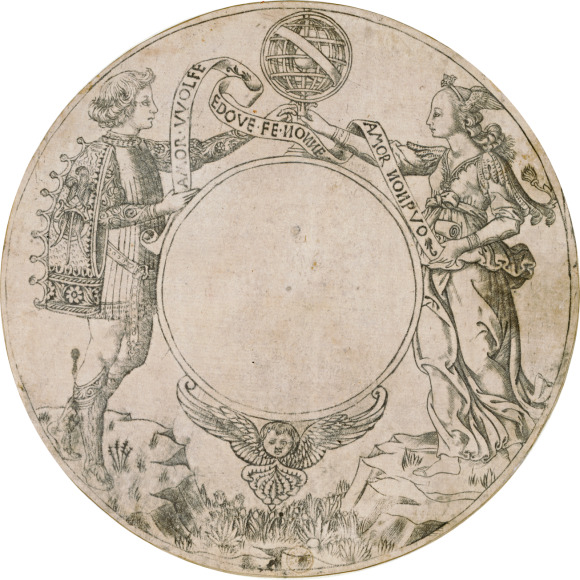
Lorenzo de’ Medici and Lucrezia Donati, “Amor vuol fe”, etching on copper, 1465-80, Paris, Bibliothèque Nationale [39.3].
In his dissertation of 1892, Warburg dedicated considerable space to the matter of Medici patronage of Botticelli’s paintings: the context of court life, in all its aspects – intellectual, philosophical, literary, ceremonial and worldly – is presented in this plate in a variety of objects: the sculptural tondo ([39.1], the prints [39.2a, 39.2b and 39.4], the paintings [39.9, 39.11a, 39.18], the drawing for the lid of a spice-box [39.3]. All of the objects are considered art productions without bias as to their typological value, all useful and invaluable documents for recalling the past. Of the engraving depicting Lorenzo de Medici and his beloved Lucrezia Donati [39.3], which was meant to adorn one of these “bossoli” (caskets used as gifts of courtship), and that Warburg attributes to the young Botticelli, he writes:
“This modest lid ornament thus presents us with a symptom of that crucial period of transition in the style of Florentine secular painting in which it strove to develop away from the painting of wedding furniture, alla franzese, and toward the antique sublimity of style afforded by the autonomous easel picture. Absorbed by the requirements of contemporary gallantry, in which secrets demanded to be simultaneously concealed and revealed, Sandro had yet to commit himself; and this was partly because his mentor, Poliziano, had yet to initiate him to the Platonic realm of the Celestial Venus. A decade or so later, this same Sandro had decisively embarked on the great stylistic shift, and was transporting the matter of medieval romance into a visual world whose reference was to antiquity. He had celebrated Lorenzo de’ Medici and Lucrezia Donati in a style of mingled realism and idealism; but now, under the influence of Poliziano, he created the quasi-antique apotheosis of Giuliano’s love of Simonetta Vespucci in the Pallas, in the Birth of Venus, and in the Realm of Venus. In order to render the gift boxes – the scatoline d’amore – entirely credible as an organic transitional stage to the free mythological easel painting on canvas, it will be necessary to undertake a stylistic analysis of the other twenty-three tondini. And another department of the applied art of courtship, hitherto equally neglected, must enter the purview of art-historical study: namely, the standards borne at tournaments, which, although lost, can be reconstructed from descriptions quite adequately for the purposes of critical study. Florentine festive pageantry, as a factor in the formation of style, must be absorbed into the history of the artistic cult and culture of the Renaissance.” (Warburg [1905b], The Renewal of Pagan Antiquity, introduction by K. W. Forster, trans. by D. Britt, Getty Research Institure for the History of Art and the Humanities, Los Angeles 1999, 177).
Warburg echoes the words of Jacob Burckhardt, according to whom the Italian festivals in their highest form are a "true transition from life to art" (Warburg [1893] 1966, 125) and in Plate 39 he composes a figurative nebula of lesser known images of everyday objects, arranging them around some of Botticelli’s masterpieces. By means of a 'parallax effect' they magnify and radiate new areas of research – Warburg's reasoning starts with famous icons of the Renaissance and finally returns to them, shedding new hermeneutical light on the paintings. This is the case of the "jousting banners", tournaments standards referred to by Warburg in the passage quoted above. In his essay on paintings by Botticelli, in particular, Warburg had already indicated in a nutshell the coordinates of a theme – the assimilation of Venus-Pallas – which traces a leading path in the lower left fascia of the plate, and reconnects with Pallas and the Centaur.
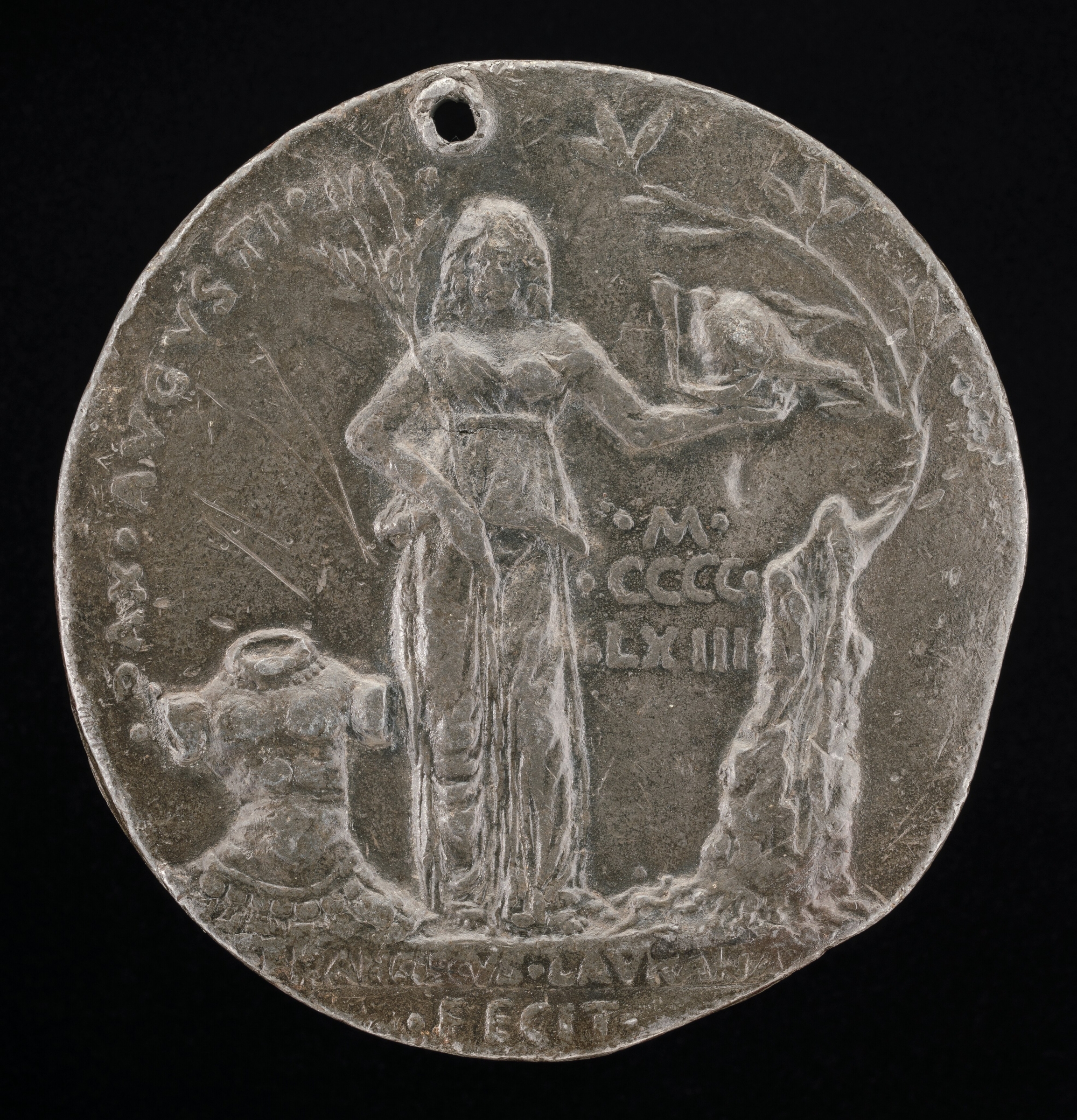
Francesco Laurana, Woman with helmet and olive branch (Minerva Pacifera), medal (verso) of René of Anjou and Jeanne de Laval, 1463-64 [39.7].
The iconographic confusion between the two divine characters, originally so very far apart – Aphrodite/love, Pallas/chastity – was already set in motion in the imperial coinage of Rome, in which the two goddesses were superimposed in the display of arms as a symbol of the triumph of peace over war – Pallas against Ares – and as the triumph of love over war – Aphrodite victorious over Ares. The allegorical identification of Venus Pax and Minerva Pax, introduces a shift in the figure of Venus into that of Pallas, explicitly manifest in the direct borrowing of the Venus-Peace of antiquity by Francesco Laurana in his medal of 1463 [39.7]. Starting from Venus, naked at birth [39.9], who appears in the middle of her garden in allegorical garments [39.11a], only to reappear in the guise of Lorenzo-Pallas taming the rebellious centaur [39.18], an allegory of civic peace imposed by Lorenzo after the Pazzi conspiracy. The image of Alma Dea retains her standing posture (one arm alongside her hip and the other gesticulating), lends herself to representing the personification of Abundance with cornucopia [39.12, 39.13, 39.14], of Peace who displays an olive branch and weapons as trophies – arms laid down, taken away or hung to a tree [39.5, 39.6, 39.7, 39.8].
What Warburg insists on pointing out, however, is principally that the legitimacy of the symbolic and figurative slippage is historically justified by a fact reported in various sources and duly noted by him, according to which Pallas Cytherea – or Minerva-Venus – was represented on Giuliano’s heraldic device in the famous joust of 1475, on burning branches: an image of a protectress but also a sublimated evocation of Simonetta, whose images bottom left of the montage in Plate 39 provide conclusive evidence of this reasoning, according to Warburg, despite the original Medici version being lost (Warburg [1893] 1966, 23-25).

Mnemosyne Atlas, plate 39 (details from Warburg and coll. version, 1929) captions 39.12, 39.13, 39.14, 39.5, 39.6, 39.7, 39.8:
39.12 Sandro Botticelli, A Nymph, Daughter of the River God Achelous (Allegory of Abudantia), drawing, 1470-80, London, British Museum, Department of Prints and Drawings; 39.13 Bernardino Pinturicchio, Female Figure with Cornucopia (Abundantia), pen drawing, about 1490, Florence, Galleria degli Uffizi, Cabinet of Prints and Drawings
; 39.14 Bernardo Buontalenti, Fortuna, drawing, 1589, Oppenheimer Collection; 39.5 Pallas, intarsia, 1476, Urbino, Palazzo Ducale; 39.6 Botticelli’s school, Pallas Athena, pen drawing, Florence, Galleria degli Uffizi; 39.7 Francesco Laurana, Woman with Helmet and Olive Branch (Minerva Pacifera), medal (verso) of René of Anjou and Jeanne de Laval, 1463-64; 39.8 After Botticelli, Pallas Athena, from a tapestry realized in 1491 for Guy de Baudreuil, Favelles, collection of Vicomte de Baudreuil.
The plot of the plate was woven not only with images of changing garments, but with images of garments that transform the principal identity of the wearer. At top right in the plate, the “wind-blown garment” transforms Achilles into a nymph, and he becomes indistinguishable from the other young girls from Scyros [39.10].
It is not so much about the myth as about the garment, the wind-blown hair, and posture – once again a standing figure, with a chaste pose – that determine the relevance of the portrayal of Achilles amongst the nymphs. The image, drawn from antiquity – in this case from a sarcophagus that could be seen during the Renaissance in the church of Santa Maria in Aracoeli in Rome – is, together with the literary references from Ovid mediated by Poliziano (incidentally, part of the materials in Plate 39 were presented at the KBW conference on Ovid in 1927: Cieri Via 2004) – a direct medium for circulating all’antica forms. Warburg observes of this image:
“As it shows, to take accessory forms in motion as the touchstone of 'antique influence' may be biased, but is not unjustified. [...] The tow adjacent life studies show how a fifteenth-century artist extracts from an antique original 'interests' him. In the present case he has taken nothing but the garment, billowing out in a elliptical curve.” (Warburg [1893], The Renewal of Pagan Antiquity, introduction by K. W. Forster, trans. by D. Britt, Getty Research Institure for the History of Art and the Humanities, Los Angeles 1999, 104-107)
In the lower right section of Plate 39 – consisting of themes beginning with rape and metamorphosis (of Chloris-Flora and Pallas who tames the Centaur: for the formulas of pathos of rape and snatching see ancient pre-coins on Plates 5, 6 in the Mnemosyne Atlas) – even Daphne in the moment she is seized by Apollo [39.15] is infused with the breath of life which swells the Nymph’s clothing; the potent semantic vitality of this engram is such that it does not cease, not even in the moment of transition to vegetal inflexibility. At the moment in which she roots herself to the bosom of welcoming Mother Earth, and from her wooden arms the first leaves begin to shoot [39.16, 39.17], the image of the young girl is still stirred by the movement of her garments and hair.

Mnemosyne Atlas, plate 39 (details from Warburg and coll. version, 1929) captions 39.7, 39.15, 39.16, 39.19:
39.7 Francesco Laurana, Woman with Helmet and Olive Branch (Minerva Pacifera), medal (verso) of René of Anjou and Jeanne de Laval, 1463-64; 39.15 Antonio Pollaiuolo, Apollo and Daphne, tempera on panel, 1472-73, London, National Gallery; 39.16 Attributed to Giovanni Pietro Birago, Apollo and Daphne, manuscript miniature, last third of the fifteenth century, Wolfenbüttel, Herzog August Bibliothek; 39.19 Bernardino Luini, Apollo and Daphne (The Tale of Myrrha?), fresco fragment, from Villa Pelucca in Monza, 1520-23, Milan, Pinacoteca di Brera.
Apart from yet another thematic drift, the subject of the metamorphosis of Daphne in the plate also opens up the theme of geographical and chronological breakdown: this section of the montage leads from the Florence of the Medici to the cultural context of Northern Italy and Germany in the early years of the Cinquecento [39.15, 39.16, 39.17, 39.19, 39.20]. As in other Mnemosyne panels, the theme of the 'migration' of ancient mythological subjects and artistic exchanges between South and North is a subject particularly dear to Warburg’s research. This shift of perspective is signalled, again, by the summary provided by the concluding image, the bronze relief that closes the plate on the lower right, just as the Medici-Riccardi tondo had suggested the themes at the beginning; by opening on to a symbolic ascent to the Empirean [39.1], the table ends with a descent to the Elysian Fields of Hades [39.20]: both figures promise immortality of the soul, a promise clearly conceived from a neo-Platonic standpoint.
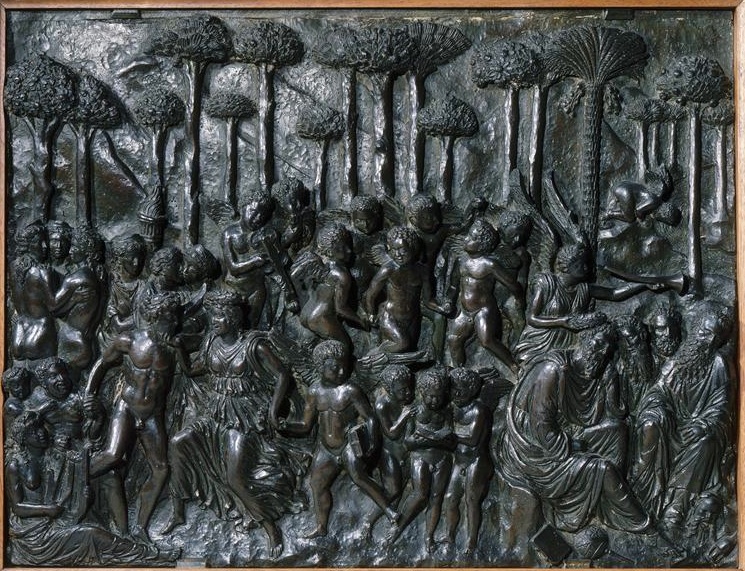
Andrea Riccio, Famous Men in the Elysian Fields, bronze bas-relief from the Della Torre funerary monument, 1520 circa, Paris, Musée du Louvre [39.20].
The funeral monument dedicated to Girolamo della Torre and his son Marcantonio (who died respectively in 1506 and 1511), made for the tomb which was located in the church of San Fermo in Verona (where a copy is currently located: the original is now in the Louvre, after it was transported there by Napoleon in 1796), was made by Andrea Briosco called Riccio and commissioned by Girolamo’s other children: Giulio, Giovanni Battista and Raimondo. The sides of the sarcophagus are decorated with eight bronze bas-reliefs depicting the story of the life, death and afterlife journey of the virtuous dedicatee: the iconographic program is intended to be philosophical and didactic, confirming the life of Girolamo della Torre as an exemplary model of ethical values. The relief has a recognizable reference to the sixth book of the Aeneid (especially in vv. 410-16, 637-44, 705-15), which describes the visit of Aeneas to the Underworld in search of his father, Anchises. In the final scene of the cycle shown in Plate 39, showing the Elysian Fields, the figure of the humanist is celebrated for the virtues he acquired in life, as a guarantee for his resurrection. Glory in the after-life is set in a lush grove, animated at the centre by a circle of winged cherubs dancing and playing music. In the forefront, three cherubs are busy reading a book together, while a fourth winged genius is being led through the garden by a robed female figure wearing wind-blown garments; the woman is dancing in the direction of a group of people sitting on the left, and invites a male figure to leave the group and join her: the act of beckoning by caressing his chin can be interpreted as erotic. The three Graces can be seen behind the group, intertwined in accordance with their ancient iconography, near a pair of lovers embracing, next to whom a female figure is holding an ignited torch, as if to signal the 'temperature' of the scene: the formal reference of these figures to the Baldini Calendar is unambiguous. In the background on the opposite side of the composition, a winged putto bends down to drink water from the river Lethe: thus purified, he is ready to return to Earth. In the foreground on the right, sits a group of four bearded men, perhaps asleep, at whose feet can be seen a book, an armillary sphere, a mask and an overturned urn; the man at the centre, probably the late Della Torre in melancholy pose, is being crowned with laurel by a winged figure holding a trumpet, the personification of Fame.
The suggested theme of the celebration of the glory of valour in works of art supplies the key to a privileged reading of the organization of the entire plate: the theme of the power of love is woven into the theme of art as a medium for immortality. From a Platonic perspective, or rather a neo-Platonic perspective, erotic mania and poetic mania are expressions of the same enthousiasmos, but they are also the route to a possible reunion between man – lover or artist – with the divine. Love, Glory and Immortality are concentrated in the image of the winged figures that populate the relief [39.20]: the hypostasis of Eros who inspires love of beauty and knowledge, together with the virtue of grace; the psychopompous daemon who unites the world with the world beyond; the genius who with the sound of his trumpet sanctions victory over death and the perpetuation of the glory of valour.
The complexity of these hermeneutical perspectives is yet again confirmed by the centrality of the Realm of Botticelli's Venus which catalyzes all the themes in the plate and presents its leading images: Cupid, the winged daemon, in the act of firing the fatal arrow; Zephyr, the winged genius, who breaks into the scene inspired by sudden passion; the Nymph become prey and transformed by love; the harmonious choir of the Graces; the whole scene stage managed by Venus and permeated with the ecstasy generated by her power.
Connections with Plates 38 and 40
Plates 38 and 40 confirm several guiding themes of Plate 39, re-presenting them with images as variations of the same significance.
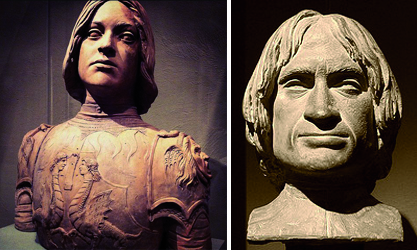
Workshop of Verrocchio, Bust of Lorenzo de' Medici, clay, 1466 circa, Boston, Museum of Fine Arts [38.11]; Stefano Ricci, Bust of Lorenzo de' Medici, earthenware, ante 1825, Oxford, Ashmolean Museum, Fortnum Collection [38.12].
The leading role of the Medici family is once again reinforced and evidenced by the portrait of Lorenzo the Magnificent prominently placed at the top of Plate 38 (top centre). If Plate 39 in the way it is mounted concentrates the most significant and dramatic moments of Giuliano’s life, the two images of Lorenzo, one produced in the workshop of Verrocchio [38.11] and the other apparently drawn from his funeral mask, the work of Pollaiuolo [38.12], signal the period between Lorenzo’s youth and death. In the left section of the montage we can still see the products of the Medici family’s courtly life: their coat-of-arms becomes a source of amusement in the engraving for the lid of a spice-box [38.5], whilst in another engraving [38.6] from the same series as fig. 39.3 a young couple dance from the effects of love. Eros is, therefore, also present in this plate at the centre of a combination of figures, but before being celebrated in an illustration for the Baldini calendar [38.7] in which the Nymph [39.2b] is also featured, the daemon is forcibly disarmed and punished [38.13, 38.14, 38.15].
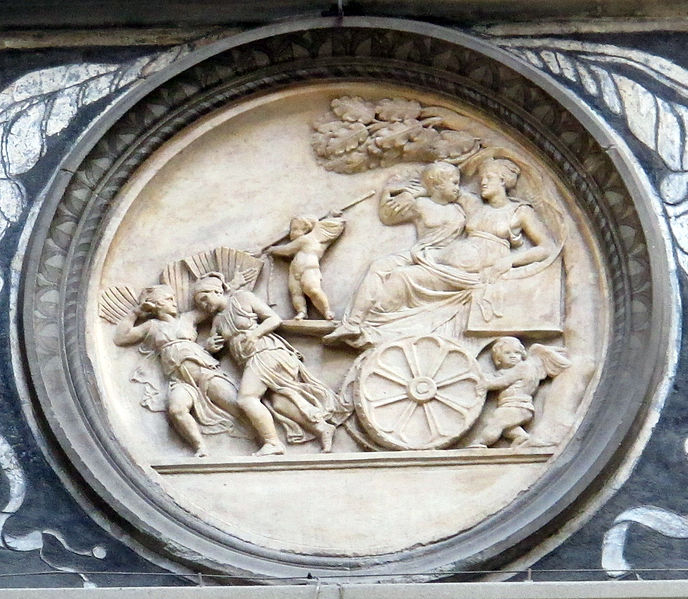
Workshop of Donatello, Bertoldo di Giovanni, Triumph of Cupid, marble tondo, 1452, Florence, Palazzo Medici-Riccardi, courtyard [40.1].
Love also triumphs in the opening image of the following plate, Plate 40, in the tondo of Palazzo-Riccardi [40.1a]; However, the climate of gratified seduction in which the children of Venus were dancing is upset by the turbulent presence of Dionysus [40.2a, 40.2b] as though the pathos heralded by the abductions in the right section of Plate 39 were progressing into the next plate. Around the central figure in Baldassare Peruzzi’s fresco of Daphne and Apollo [40.10c] we can witness scenes of violent aggression unfolding. The bestiality of the centaur – an image that appears in a tondo in Palazzo Medici-Riccardi [40.1b] – tamed by Pallas-Lorenzo in Plate 39, in this case has no restraint. The gesture of his extended arm with an object gripped in his hand is no longer a conciliatory gesture associated with the goddess of wisdom but the ferocious act of soldiers in the Massacre of the Innocents [40.6, 40.8, 40.9].
Bibliographical references
- Bacchi, Giacomelli 2008
Rinascimento e passione per l'antico. Andrea Riccio e il suo tempo, catalogo della mostra (Trento, 5 luglio-2 novembre 2008), a cura di A. Bacchi, L. Giacomelli, Milano 2008. - Beltrami 1906
L. Beltrami, Gli affreschi del Luini alla Pelucca, Milano 1906. - Bing [1960] 2003
G. Bing, Aby Warburg, in "Rivista storica italiana" LXXII, 1960, 100-113, ora in "La Rivista di Engramma" 116 (maggio 2014). - Bordignon 2004
G. Bordignon, L'espressione antitetica in Aby Warburg. La polarità semantica dei gesti dalle Pathosformeln all'arte del Rinascimento, "La Rivista di Engramma" 32 (aprile 2004). - Chiappa 1993
B. Chiappa, I Della Torre fra Cinquecento e Seicento, in Villa Della Torre a Fumane, a cura di A. Sandrini, Verona 1993, 65-85, 70, 82 and n. 26. - Centanni 2013
M. Centanni, 26 aprile, giorno di primavera: nozze fatali nel giardino di Venere. Una rivisitazione della lettura di Aby Warburg dei dipinti mitologici di Botticelli, "La Rivista di Engramma" 105 (aprile 2013). - Carson 2010
R.A. Carson, Andrea Riccio's Della Torre Tomb Monument: Humanism and Antiquarianism in Padua and Verona, Ph. D. Thesis, University of Toronto, 2010. - Cieri Via 2004
C. Cieri Via, Un'idea per le Metamorfosi di Ovidio, in C. Cieri Via, P. Montani, Lo sguardo di Giano. Aby Warburg fra tempo e memoria, a cura di B. Cestelli Guidi, M. Forti, M. Pallotto, Torino 2004, 305-343. - Dacos, Giuliano, Pannuti 1973
Il tesoro di Lorenzo il Magnifico. Le gemme, a cura di N. Dacos, A. Giuliano, U. Pannuti, catalogo delle mostra (Firenze, Palazzo Medici Riccardi, 1972), Firenze, 1973. - Gennaioli 2007
R. Gennaioli, Le gemme dei Medici al Museo degli Argenti: cammei e intagli nelle collezioni di Palazzo Pitti, Firenze, 2007. - Rappl 2003
W. Rappl, La clef des songes. Il materiale per "Mnemosyne" di Aby Warburg e il linguaggio della memoria, "Quaderni Warburg Italia" 1, L'Atlante della memoria. Filosofia delle immagini per un lessico warburghiano, Firenze 2003, 39-92. - Warburg [1893] 1966
A. Warburg, La “Nascita di Venere” e la “Primavera” di Sandro Botticelli. Ricerche sull’immagine dell’antichità nel primo Rinascimento italiano [1893], in La rinascita del paganesimo antico, a cura di G. Bing, tr. it. di E. Cantimori, Firenze 1966, 1-58. - Warburg [1895] 1966
A. Warburg, I costumi teatrali per gli intermezzi del 1589. I disegni di Bernardo Buontalenti e il “Libro di conti” di Emilio de’ Cavalieri [1895], in La rinascita del paganesimo antico, a cura di G. Bing, tr. it. di E. Cantimori, Firenze 1966, 59-107. - Warburg [1905a] 1966
A. Warburg, Scambi di civiltà artistica fra Nord e Sud nel secolo XV [1905a], in La rinascita del paganesimo antico, a cura di G. Bing, tr. it. di E. Cantimori, Firenze 1966, 171-178. - Warburg [1905b] 1966
A. Warburg, Delle “Imprese amorose” nelle più antiche incisioni fiorentine [1905b], in La rinascita del paganesimo antico, a cura di G. Bing, tr. it. di E. Cantimori, Firenze [1966] 1996, 179-191.
Web references
A first version of this reading on Plate 38 of Mnemosyne Atlas in "La Rivista di Engramma" 4 (dicembre 2000)
Plate 39 of Mnemosyne Atlas is focused on the figure of Venus and her Triumphs as well as on the daemon of Eros, the winged genius of Love. The plate focuses on the so-called Botticelli's mythological cycle – The Birth of Venus, Primavera, Pallas and Centaur: the central theme is closely related, from the historical standpoint, to the Medici's patronage, to the philosophy of Marsilio Ficino, and to the relationship of love and death between Giuliano de Medici and the "nymph" Simonetta. The reading of the plate describes how in the same cultural context an ideal style "all'antica" was born and how it appears via the “wind-blown garment” of the moving figures in the scenes of metamorphosis and passional abductions. The subject of metamorphosis leads to a cronological and geographic shift, from the Florence of the Medici to further cultural contexts. The theme of the power of Love is intertwined with that of Art as ways to achieve immortality: both erotic and poetic mania can be considered media for the Neoplatonic reunion between man, as a lover and as an artist, and the Divine.
keywords | Metamorphosis; Medicean Florence; Plate 39; Mnemosyne Atlas; Seminary; Love.
To cite this article: Seminario Mnemosyne, Metamorphoses of the Virtues of Love in Medicean Florence. A Reading of Plate 39 of the Mnemosyne Atlas, “La Rivista di Engramma” n. 116, maggio 2014, pp. 26-43 | PDF